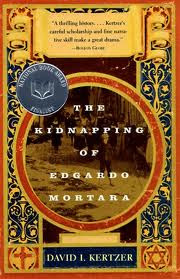 Thanks to this year's 48 Hour Reading Challenge (of which I have two hours left...) I have finally finished a book I have owned unread for about eight years, if not more-- The Kidnapping of Edgardo Mortara, by David Kertzer (1997; a National Book Award Finalist). It's an outstanding example of social history, and was one of the most gripping books, including all the fiction I read, that I've encountered this year. I am now a much more educated person. So total win.
Thanks to this year's 48 Hour Reading Challenge (of which I have two hours left...) I have finally finished a book I have owned unread for about eight years, if not more-- The Kidnapping of Edgardo Mortara, by David Kertzer (1997; a National Book Award Finalist). It's an outstanding example of social history, and was one of the most gripping books, including all the fiction I read, that I've encountered this year. I am now a much more educated person. So total win.Here's the story: One evening in Bologna, in June of 1858 two officers of the Inquisition knocked on the door of Momolo Mortara, a Jewish businessman. They had come to take, by force if necessary, Mortara's son, little Edgardo. Unbeknownst to the Mortara family, a Catholic servant had baptized him some years before, transforming him into a Christian. As such, the six year old boy could not remain with his Jewish family, but must be raised as a Catholic.
The kidnapping of Edgardo launched a media firestorm, and became a cause célèbre. The mid 19th century was a tumultuous time for Italy--liberals pushed for unification of its desperate states and for constitutional government, and the Catholic church fought to preserve its absolute power over the Papal state (a considerable territory, surrounding Rome). Each side put their own spin on Edgardo's story, in a way very reminiscent of the media today--were Edgardo and his family victims of an enlightened, cruel institution that clung to the past, or was the Catholic church doing its duty in saving the soul of an innocent child, whose heart (according to their accounts) soon turned with love toward the Catholic faith?
Kertzer vividly brings to life the antisemitism of 19th-century Italy (who knew the Inquisition was still going strong, and that Blood Libel was still unquestioned by the many? Not me). Using direct quotes from historical sources extensively, he allows the protagonists in the drama to tell their own stories, guiding the reader through the maze of political and legal intrigue. The cast of characters ranges from the statesmen, rulers, and revolutionaries that I'd heard about (Garibaldi, Napoleon III, President Buchanan), to uneducated peasant girls whose court testimony gives them a voice.
Though I sometimes got a bit confused with all the mad welter of events of Italy's path toward unification, Kertzer kept coming back to Edgardo and his family enough so that the human interest of their story was never lost.
I was appalled, educated, and entertained (and have become determined to read more social history for grown ups).
But for now, back to science fiction and fantasy for the young.






































